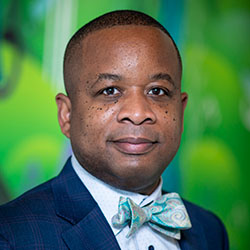Meet Dr. Andre Dick, Surgeon-in-Chief and Kidney Surgical Director
August 3, 2022
 Dr. André Dick is Seattle Children’s senior vice president and surgeon-in-chief and serves as surgical director of the pediatric kidney transplant program. Dr. Dick became Seattle Children’s interim senior vice president and surgeon-in-chief in May 2021, then assumed the role permanently in March 2022. He’s a transplant surgeon but also a natural leader with big goals to address social determinants of health and provide equitable access for all our patients. He strives to be a beacon for those who are underrepresented in surgical and leadership roles.
Dr. André Dick is Seattle Children’s senior vice president and surgeon-in-chief and serves as surgical director of the pediatric kidney transplant program. Dr. Dick became Seattle Children’s interim senior vice president and surgeon-in-chief in May 2021, then assumed the role permanently in March 2022. He’s a transplant surgeon but also a natural leader with big goals to address social determinants of health and provide equitable access for all our patients. He strives to be a beacon for those who are underrepresented in surgical and leadership roles.
How long have you been at Seattle Children’s, and what were your previous roles?
I came as an abdominal transplant fellow in 2006 and have been on faculty since 2008. I’ve been the surgical director for the Pediatric Kidney Transplant Program since 2015 and still serve in that role. I also served as the medical director of the Surgical Unit and the transplant surgery fellowship director prior to becoming surgeon-in-chief.
What inspired you to specialize in transplant surgery?
When I was a medical student, I spent a summer working with a pediatric surgeon. At that time, I had no idea what a pediatric surgeon was, but I realized it was something I wanted to do. Throughout the rest of medical school, I spent whatever free time I had with him in the clinic or conducting research in his lab.
Ultimately, I went into residency and said I wanted to do pediatric surgery. It didn’t work out the way I planned, but when I finished, I still wanted to work with kids. My mentor was a transplant surgeon, and he said, “You can work with adults and kids if you do transplant.” So, I strategically applied for transplant fellowships at places that had good reputations with pediatric transplants. When I applied to the University of Washington (UW), the new division chief at UW was known for his work in pediatric transplantation. I ended up interviewing, matching and staying in Seattle.
Tell me about the surgeon-in-chief role.
It entails two things: providing leadership in strategic planning and implementation of programs that will make the organization successful, while also advocating for Surgical Services so the divisions are equipped to deliver high-quality and equitable care. It’s a thin line — you have to advocate for your constituents, while at the same time have them align with the larger strategic vision of the organization. It’s a big role, and I’m excited to be able to make a difference.
This role is a great accolade, but it’s much bigger than me because there aren’t a lot of people of color in high leadership roles. As one of the few black surgeons at Seattle Children’s and the UW, I hope my being in this role will shine as a beacon so other people can say, “I can also accomplish that.” I want to create a path for those who follow after me.
What are your top priorities?
The biggest priority is our health equity and antiracism work. Recently, Surgical Services and Odessa Brown Children’s Clinic launched the social determinants of health initiative. Social determinants of health are the things that impact people’s lives before they interact with the healthcare system. We’re collecting information about things like food insecurity, transportation, financial strains and housing instability to better understand patient needs and barriers to care so we can prioritize health equity. We started small in Surgical Services but are continuing to expand and hope that by the end of this year this will be implemented across the entire organization.
Social determinants of health aren’t things that I, or even our organization, can solve. We’ll use the data we collect to partner with the community and legislators at the local, regional and even national level to create policies that help mitigate those determinants. If I can help move the needle even an inch, I’ll be happy. This is something that could take the rest of my career.
The second part of my big vision is continuing to expand clinical capacity so we can provide access and equitable care for all of the patients and families we serve. I’m not aware of any other children’s hospital that serves this large of a region, and within that region, there’s diversity in ethnicity, language and geography. Those needs are all different — it’s not one size fits all. So, this is an opportunity to lead the way and provide a blueprint for other places.